
The Ultimate Guide to Body Casket Types and Information
Understanding Body-Casket- Options for Your Funeral Home
When families search for body-casket- information, they need clear guidance during one of life's most difficult moments. A body casket serves as the final resting place for their loved one, whether for burial or cremation services.
Quick Body-Casket- Overview:
- Casket vs. Coffin: Caskets are rectangular; coffins are six-sided and tapered
- Main Materials: Wood (pine to mahogany), metal (steel to bronze), eco-friendly (bamboo, cardboard)
- Lid Styles: Half-couch (upper body viewing) or full-couch (full body viewing)
- Price Range: $400-$12,000 depending on material and features
- Buying Rights: FTC Funeral Rule allows third-party casket purchases without extra fees
The choice between different body-casket- styles affects everything from viewing ceremonies to long-term preservation. Families often feel overwhelmed by the variety of materials, from traditional hardwoods to modern eco-friendly options.
Why do funeral homes cover legs in viewings? Practical reasons include fitting standard casket sizes, concealing trauma or decomposition effects, reducing embalming costs, and creating better lighting for the service.
As Mortuary Cooler, I've spent years helping funeral directors understand the technical aspects of body-casket- storage and preparation equipment. My experience with mortuary cooling systems has shown me how proper body-casket- selection directly impacts the quality of services funeral homes can provide to grieving families.
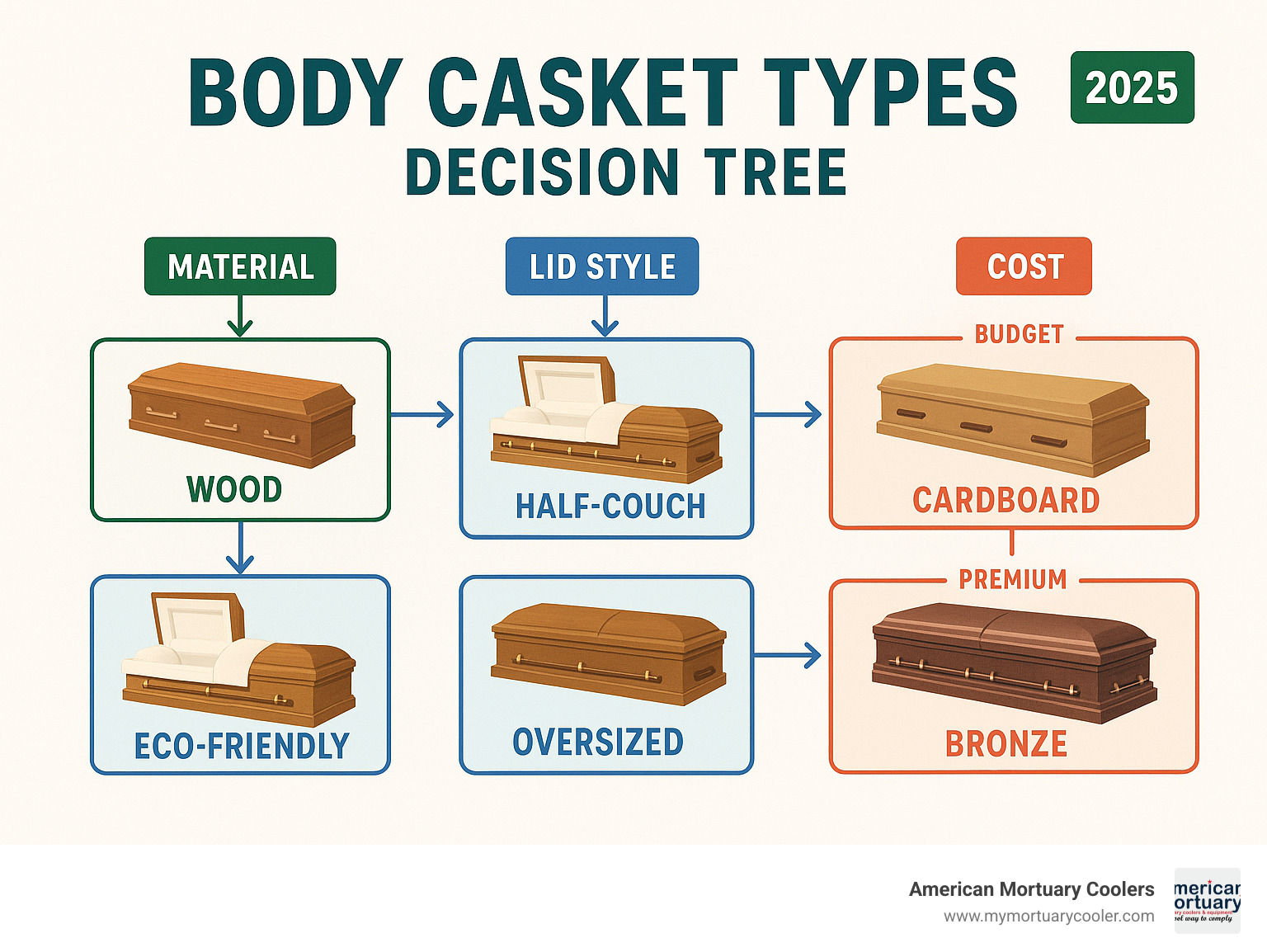
Key body-casket- vocabulary:
Coffin vs. Casket: Shape, History, Terminology
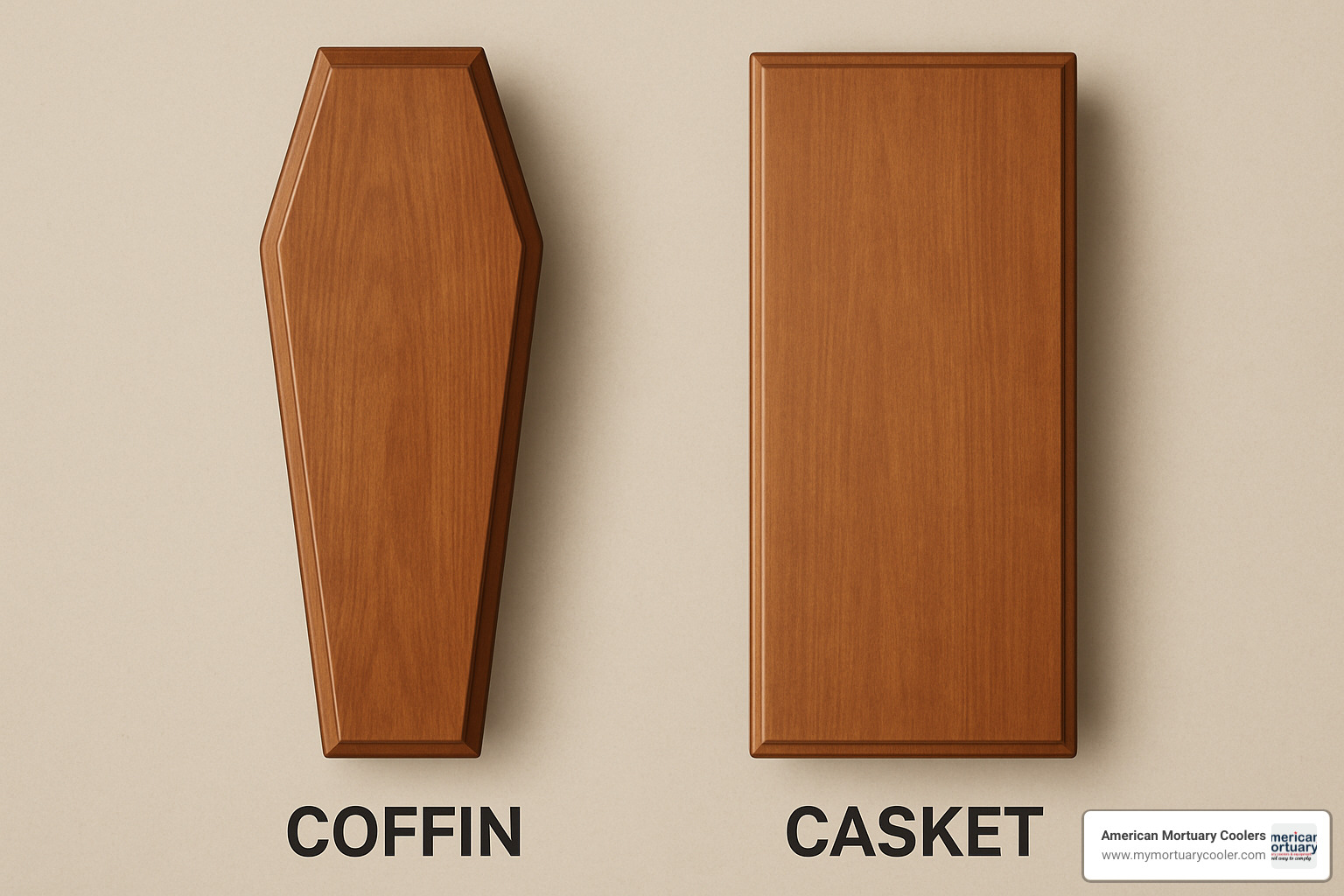
Most people think "coffin" and "casket" mean the same thing, but they're actually quite different. Coffins have that distinctive six-sided shape that's wider at the shoulders and tapers down toward the feet. Caskets are perfectly rectangular boxes with four straight sides and a hinged lid.
The biggest practical difference? Wood usage and cost. Coffins use about 15-20% less material because of their tapered design, while caskets require more lumber but offer more interior space.
| Feature | Coffin | Casket |
|---|---|---|
| Shape | Six-sided, tapered | Rectangular |
| Wood Usage | Less (more economical) | More (higher cost) |
| Lid Style | Removable | Hinged |
| Interior Space | Body-contoured | Consistent width |
| Common Usage | International | Primarily U.S. |
The Federal Trade Commission's Funeral Rule protects your right to buy either coffins or caskets from outside vendors. Funeral homes cannot charge you extra fees for accepting a body-casket- you purchased elsewhere.
More info about coffin covering options
Why the U.S. Says "Casket"
The switch from "coffin" to "casket" wasn't just about language—it was about rebranding death itself. During the mid-1800s, American funeral directors started using "casket" because it sounded gentler and more comforting to grieving families.
The word "casket" originally meant a small, precious box for storing jewelry. By using this jewelry-box analogy, funeral directors could present the final resting place as something beautiful rather than a stark reminder of death.
Can You Skip the Box Altogether?
Natural burial is becoming increasingly popular, and many cemeteries now allow burial without any container at all. Green cemetery rules vary by location, but many permit simple shrouds made from cotton, linen, or wool.
Some families choose biodegradable options like simple pine boxes, wicker containers, or cardboard for direct cremation. Natural burial offers a way to return to the earth more directly, though it's not available everywhere.
The Anatomy and Materials of a Body-Casket-
When you're choosing a body-casket-, understanding its construction helps you make decisions that truly matter to your family. Every casket has four main parts: the shell (the main body), the lid (the top that opens), the interior (where your loved one rests), and the hardware (handles, hinges, and decorative elements).
More info about Body Casket Options
Shell, Lid & Hardware Explained
The shell forms the foundation of any body-casket- and includes the ogee (decorative rim), the crown (top section), and the pie (curved end sections). Lid styles make a bigger difference than most people realize. A full-couch lid opens completely, while a half-couch lid has two sections with only the top opening for upper body viewing.
The hardware serves real purposes. Swing bars are handles that fold down for pallbearers and are engineered to support significant weight safely. Stationary bars on budget models don't move but still provide secure grip points.
Popular Materials and Their Pros/Cons
Wood caskets remain America's favorite choice. Hardwoods like mahogany offer rich, dark grain ($3,000-$8,000), cherry develops gorgeous reddish patina ($2,500-$6,000), and oak delivers classic American looks ($2,000-$5,000). Softwoods like pine provide solid wood construction at $800-$2,000.
Metal caskets offer different advantages. 20-gauge steel provides standard protection ($1,200-$3,000), while 18-gauge offers heavier construction ($1,800-$4,000). Bronze will never rust but costs $8,000-$15,000, while copper offers excellent corrosion resistance for $6,000-$12,000.
Eco-friendly materials include bamboo ($900-$1,500), wicker ($800-$1,400), and cardboard for direct cremation ($150-$400).
Scientific research on modern casket materials
Viewing Styles & Specialized Body-Casket- Types
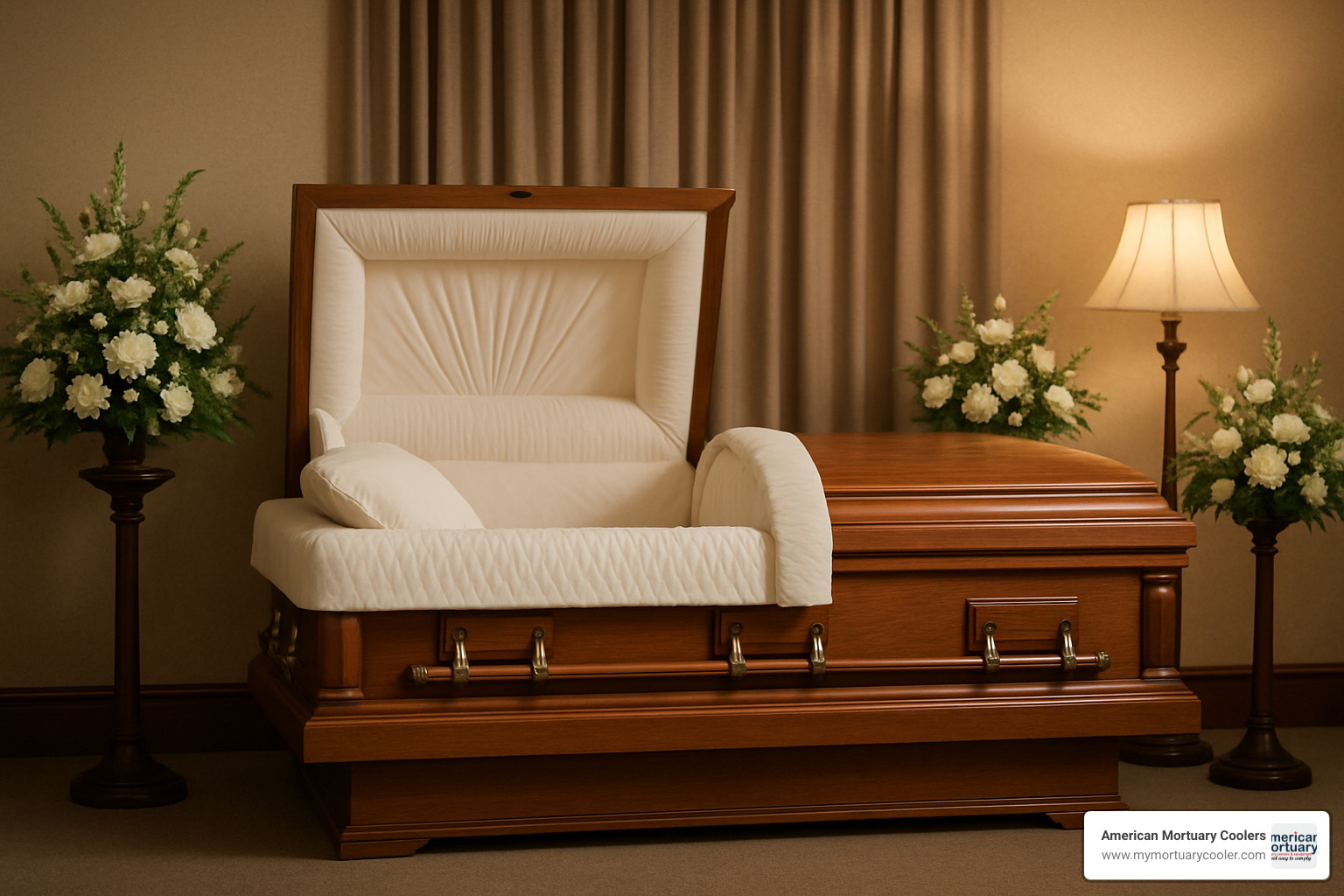
When families choose a body-casket-, the viewing style becomes one of their most important decisions. This choice shapes how their loved one will be remembered during the final farewell ceremony.
More info about Casket Selection
Half Couch vs. Full Couch Lids
Half-couch caskets open only at the top portion, showing your loved one from about the waist up. This has become the standard choice in American funeral homes for practical reasons.
Standard caskets measure only 84 inches long, meaning anyone over 6 feet tall needs their legs positioned at an angle. The half-couch design solves this by keeping the lower portion closed. Decomposition and body fluids often collect in the feet first, causing swelling that might upset family members.
Full-couch caskets open completely, revealing the entire person. Families choose this when they want complete viewing or when cultural traditions call for it.
Specialty Options: Oversized, Rental, Fantasy, Eco-Friendly
Oversized caskets serve families whose loved ones need more space than standard 28-inch wide models. These range from 29-inch width up to 44-inch width available by special order.
Rental caskets offer an ingenious solution for families planning cremation but wanting a traditional viewing service. These feature removable inner containers that look identical to permanent caskets during the service. After the ceremony, the inner container goes to cremation while the casket returns for future use.
Fantasy caskets celebrate the person's passions - musicians might rest in guitar-shaped designs, while car enthusiasts could choose automotive-themed caskets. Eco-friendly specialty caskets use biodegradable materials like bamboo or wicker with no metal hardware.
Memory tubes represent another thoughtful feature - small containers built into the casket that hold letters, photos, or mementos that family members want to keep with their loved one forever.
What Happens to the Body in a Casket Over Time
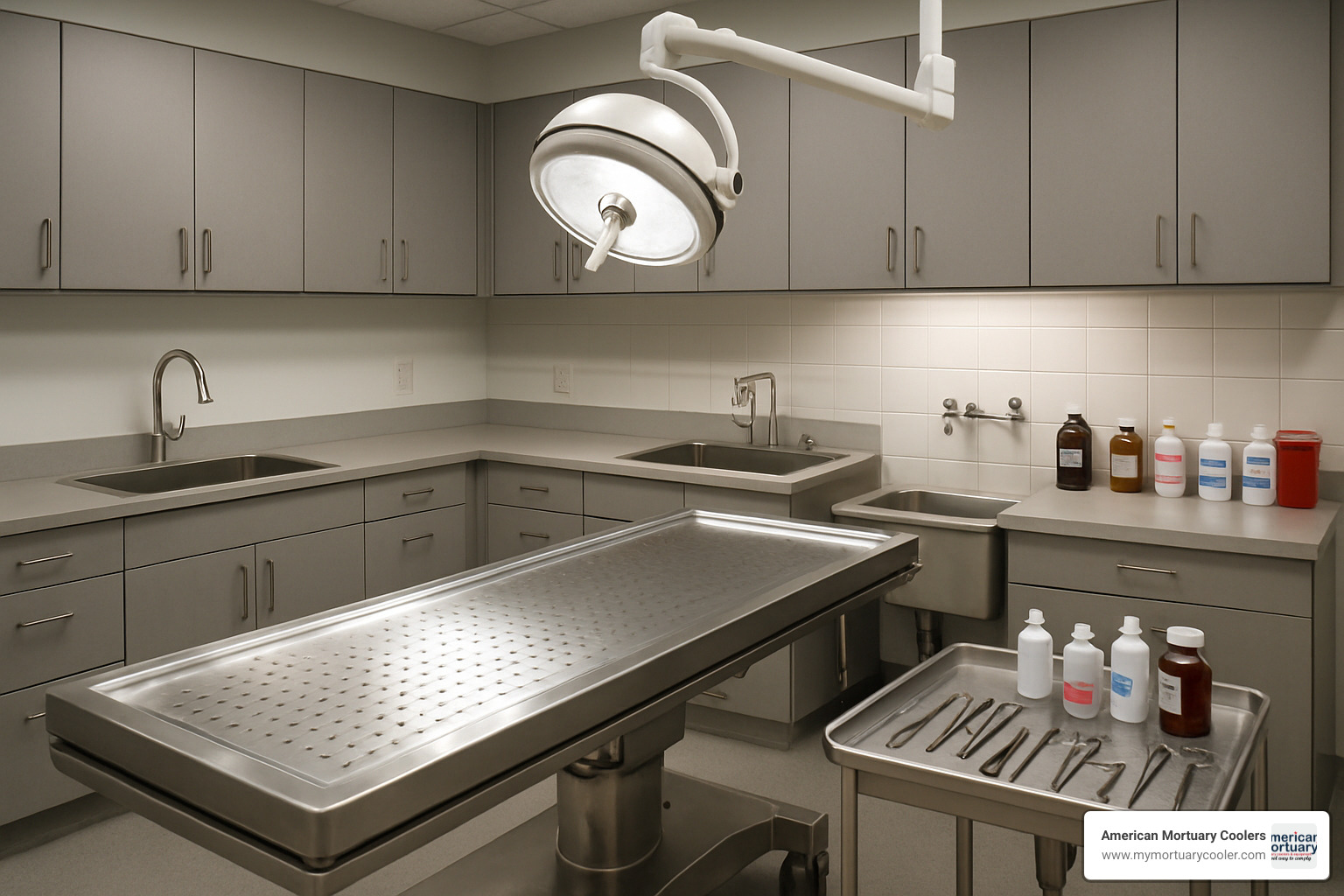
This is perhaps the most difficult topic families face when choosing a body-casket-, but understanding what happens after burial helps you make informed decisions. No casket can preserve a body forever—and that's actually part of nature's design.
The human body begins its natural change about three days after death. Enzymes that once helped digest food now start breaking down the body's own tissues through "self-digestion."
Scientific research on embalming practice
Embalming 101: Process & Impact
Embalming temporarily slows decomposition by replacing the body's blood and fluids with formaldehyde-based chemicals. The process involves pumping formaldehyde solution through the circulatory system while draining blood and other fluids.
Appearance preservation through embalming can create natural-looking results when done skillfully. However, the body will feel firmer due to chemical treatment. Poor embalming can produce disturbing results with grayish, waxy, or artificially colored appearance.
Each embalming generates up to 120 gallons of chemical wastewater that enters public sewer systems, leading many families to consider green burial alternatives.
Natural Decomposition & Vault Influence
Without embalming, natural decomposition follows predictable stages based on temperature, moisture, and soil conditions. Self-digestion begins within days as the body's enzymes break down tissues.
In certain conditions, adipocere or "grave wax" can form. This waxy substance can preserve body features for decades when moisture levels are right and insects can't reach the remains.
Moisture barriers created by burial vaults can delay decomposition for hundreds of years. Gas build-up in sealed environments can create pressure causing "exploding casket" syndrome. Many cemeteries now break gasket seals on metal caskets to prevent this.
Pacemaker removal is required before burial or cremation because these devices can explode from gas pressure or cremation heat. The FTC prohibits funeral homes from claiming any body-casket- can preserve remains indefinitely.
Costs, Consumer Rights, and Buying a Body-Casket-
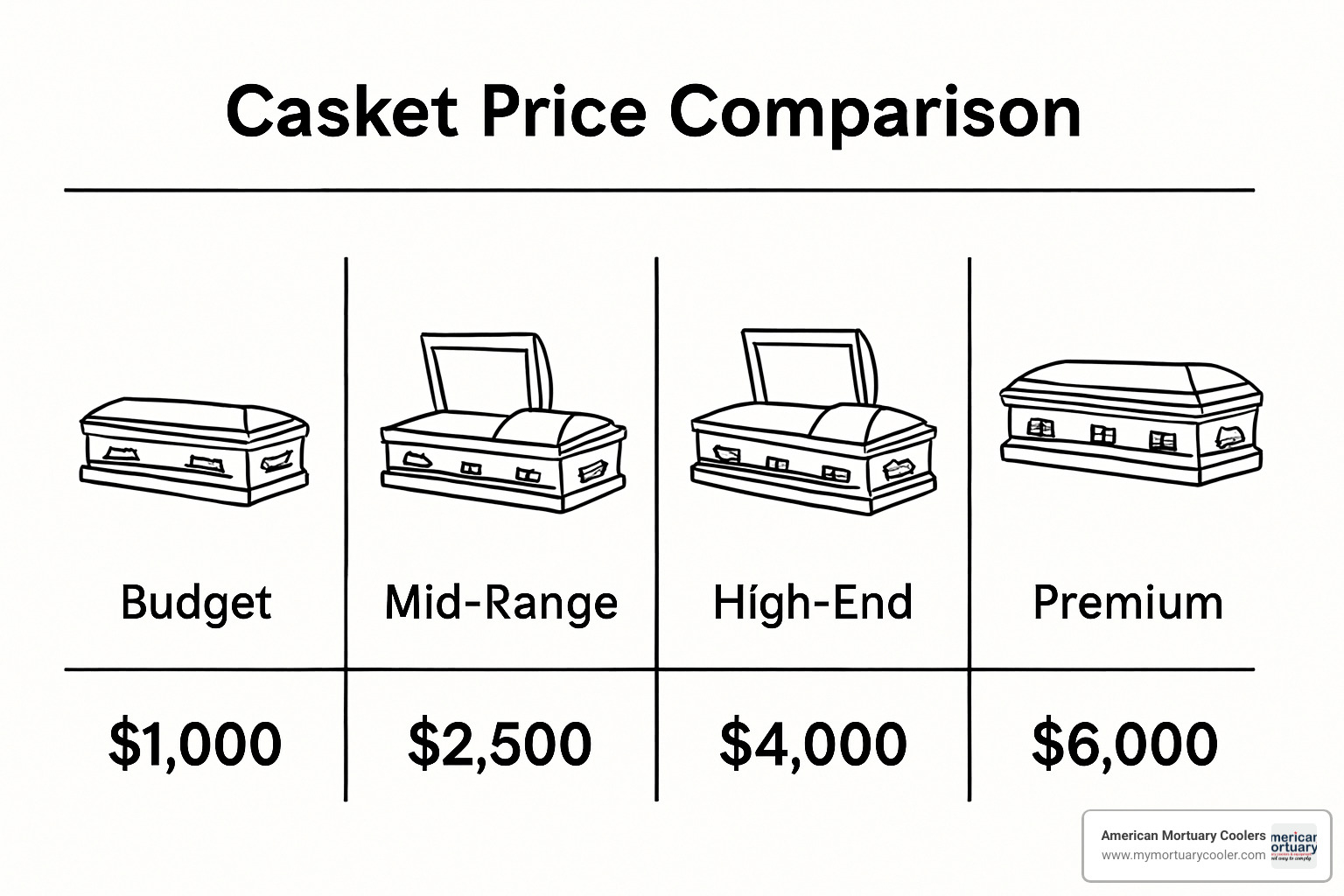
When families face choosing a body-casket-, understanding pricing helps them make decisions that honor their loved one without creating financial stress. Funeral homes often charge over $2,000 for caskets that cost them far less, with markups reaching 300% or more.
Families can save up to 85% by purchasing their body-casket- online instead of through the funeral home.
More info about Understanding Casket Prices
Price Drivers: Material, Gauge, Craftsmanship
The cost of a body-casket- comes down to three main factors: material, construction, and craftsmanship.
Material quality makes the biggest difference. Solid hardwoods command premium prices, while engineered wood with veneer offers beautiful appearance at a fraction of the cost. For metal caskets, gauge thickness directly impacts price - lower gauge numbers mean thicker metal and higher costs.
Craftsmanship details like hand-rubbed finishes, quality interior fabrics, and solid hardware all add cost. Interior lining materials from crepe to satin or velvet also influence final pricing.
Where to Buy: Funeral Home vs. Online
Funeral homes offer personal guidance and the ability to see products firsthand, but at premium prices. Online retailers offer dramatic cost savings but require more planning and coordination.
The FTC Funeral Rule prohibits funeral homes from charging extra fees when you bring your own casket. Delivery logistics typically take 3-5 business days with fees of $300-$600, but families usually still save thousands compared to funeral home prices.
Eco-Friendly & Budget Alternatives
Cardboard caskets start around $150 and can be customized with artwork or personal messages. Natural material options like bamboo ($900-$1,500) and wicker ($800-$1,400) offer beautiful appearances while supporting sustainable practices.
Rental programs offer traditional viewing appearance without full cost - the inner container is removed for cremation while the outer casket is reused. Pine boxes represent the simplest wood option at $400-$800, while shroud burial using natural fabrics costs only $50-$200.

Frequently Asked Questions about Body-Casket-
When families are making decisions about their loved one's final arrangements, they often have similar questions about body-casket- options.
What is the difference between a coffin and a casket?
The shape tells the whole story. Coffins have that distinctive six-sided design that tapers in at the head and feet. Caskets are rectangular boxes that keep the same width from head to toe.
American funeral directors started using "casket" in the 1800s because it sounded gentler than "coffin." They wanted people to think of a jewelry box rather than a box for dead bodies.
Coffins typically cost less because they use less wood, while caskets often feature fancier materials and craftsmanship.
Why are the legs often covered in a body-casket- during viewings?
Size matters - Standard caskets are 84 inches long, but many people are taller. When someone doesn't fit perfectly, funeral directors bend the knees slightly, and covering the legs keeps this positioning dignified.
Decomposition effects create another challenge. After death, fluids settle in the lower extremities, causing swelling and discoloration that's difficult to correct. Trauma concealment becomes necessary when the cause of death affects the lower body.
Cost savings play a role too. Embalming only the visible portion reduces both chemical costs and preparation time. Half-couch caskets have become the American standard, with the closed lower section providing space for flower arrangements.
Can a person be buried without any body-casket- at all?
Absolutely. Natural burial is becoming increasingly popular. Green cemeteries specifically allow shroud burials using biodegradable materials like cotton, linen, or wool. Some permit direct earth burial without any container.
Simple alternatives include basic pine boxes, wicker containers, bamboo caskets, or cardboard for cremation. The catch is that traditional cemeteries often require burial vaults or grave liners.
Home funerals are legal in all 50 states, and families choosing this route can often skip the body-casket- purchase entirely.
Conclusion
Making the right body-casket- choice during one of life's most challenging moments requires balancing emotional needs with practical considerations. The decision should honor your loved one's memory while respecting your family's values and budget.
Today's funeral landscape offers more options than ever. Online retailers provide substantial savings compared to traditional funeral home markups. Green burial alternatives continue gaining acceptance as families seek environmentally conscious ways to say goodbye.
No casket material can preserve a body forever, despite marketing claims. The FTC Funeral Rule protects your right to purchase from any vendor without additional fees. These protections help families avoid high-pressure sales tactics during vulnerable times.
At American Mortuary Coolers, we've spent years supporting funeral homes with professional equipment they need to serve families with dignity. Our custom mortuary coolers work alongside whatever body-casket- families choose, ensuring proper preparation and presentation. From our facilities in Tennessee to our delivery routes across all 48 contiguous states, we understand how quality equipment supports meaningful final tributes.
The funeral directors we serve in Tennessee, Georgia, Illinois, South Carolina, Texas, California, New York, and Pennsylvania know that quality equipment makes the difference between adequate service and exceptional care.
More info about mortuary cooler solutions
Your body-casket- selection represents more than a purchase decision. It's part of creating a final tribute that brings comfort to those left behind. Trust your instincts, use the information you've learned, and make the choice that feels right for your family.



